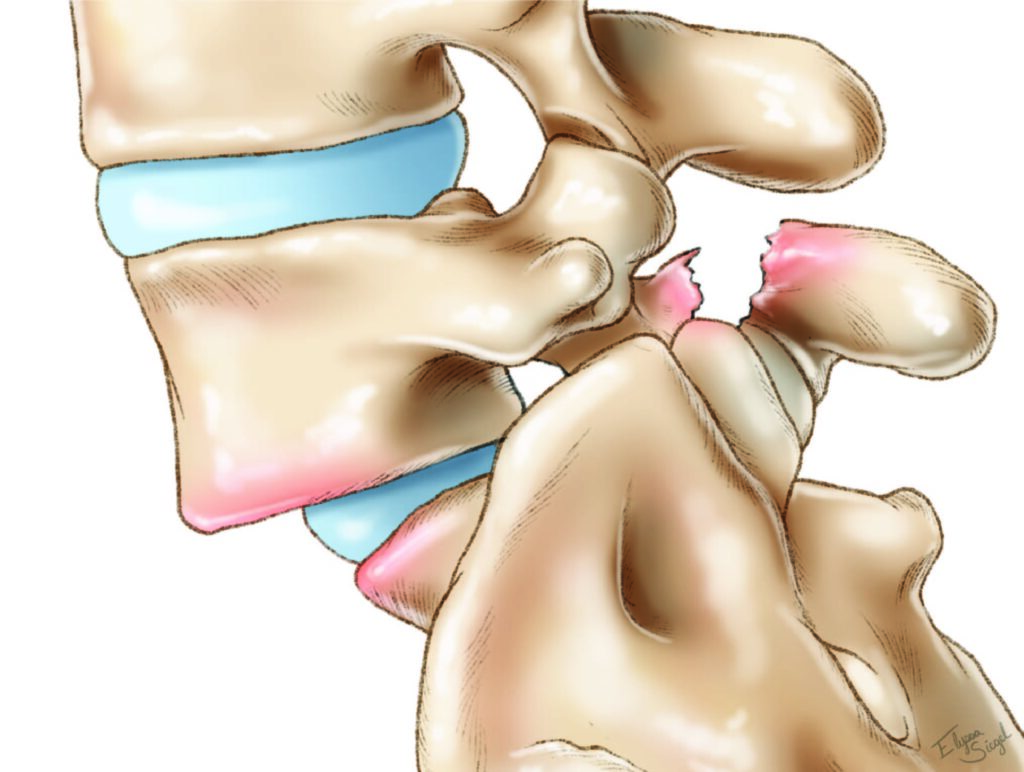Spondylolisthesis
Spondylolisthesis occurs in the lower back and is the forward slipping of a vertebra onto the vertebrae below it.
What’s in this section?
Signs and symptoms
Symptoms of spondylolistheisis depend on the severity of the slip and often include:
- Lower back pain or tenderness
- Back and leg stiffness
- Thigh pain
- Hamstring or buttock muscle tightness

Potential Causes
Spondylolisthesis can be hereditary or caused by a birth defect. It can also be the result of sports that overstretch and put excessive stress on the low back.
Diagnosis
Diagnosis of spondylolisthesis starts with a physical exam and medical history. Other procedures and tests may be needed to diagnose spondylolisthesis, including x-rays or computed tomography (CT).
Treatment options
There are different treatment options depending on the severity of your symptoms:
- A back brace to support the spine.
- Physical therapy to strengthen the surrounding muscles.
- Medication to control pain.
- Epidural steroid injections. These injections are used to inject a steroid and a local anesthetic into the space around your spine to help decrease inflammation and swelling, typically leading to improvement in pain. This procedure is performed in either the office or surgery center setting and typically takes just a few minutes. Most procedures involve a needle that is advanced to the target area using fluoroscopic (x-ray) guidance. A small amount of x-ray contrast will be injected to confirm accurate placement. Once the needle has been properly placed, a combination of a local anesthetic and/or injectable steroid will be placed into the targeted area.
- Minimally invasive fusion. The most common reason for a lumbar fusion is instability of the spine resulting in a pinched nerve, causing pain, numbness, weakness or a combination of these symptoms. A minimally invasive fusion is the same operation for the same reasons, but performed in a minimally invasive fashion, which causes less damage to the muscles and surrounding tissues. There are many different techniques for performing a minimally invasive lumbar fusion. The surgery can be performed going through the front underneath the belly button, from the side underneath the rib cage, or from behind. Minimally invasive surgery through the lower back typically means dilating a small pathway through the muscles rather than stripping the muscles away from the bones of the spine. There are special retractors designed to protect the muscles and cause less damage to these tissues while performing essentially the same operation.
- Posterior lumbar decompression and fusion surgery. This procedure is performed to take pressure off of the nerves in the lower back, and to treat or prevent instability of the lower spine. This surgery is typically done for patients with abnormal alignment, such as spondylolisthesis. Patients who are good candidates for surgery usually have back and leg symptoms: pain, weakness, changes in sensation and trouble standing up straight or walking distances. The surgery is performed through an incision in the middle of the lower back. Your surgeon will remove a window of bone, a procedure called a laminectomy, as well as ligament and parts of the joints of the spine to take the pressure off of the nerves. The fusion portion of the procedure involves using screws and rods to connect bones of the spine together, along with placing bone graft material which will grow over time, typically 6 – 12 months, and fuse the bones of the spine together.
Conditions
Request an appointment online and we will guide you through the next steps
Get to know the physicians of Goodman Campbell
Goodman Campbell
Patient Stories
Request an appointment online and we will guide you through the next steps.
